Physical Address
304 North Cardinal St.
Dorchester Center, MA 02124
Tracheal resection: segmental resection
Bronchoscopy: assessment
Mediastinoscopy: assessment
Wedge resection: non-anatomical wedge
Segmentectomy: segment or multiple segments
Lobectomy: lobe
Sleeve lobectomy: lobe with segment of bronchus or pulmonary artery
Pneumonectomy: whole lung
The adult trachea averages 11.8 cm in length (range 10–13 cm). Typically, there are 18–22 cartilaginous rings. The larynx and the origin of the oesophagus are intimately related at the level of cricopharyngeus. Below this level, the posterior membranous wall of the trachea is closely related to the oesophagus. This proximity means that diseases such as cancer affecting either structure can involve the other, and that damage of both structures can result in a tracheo-oesophageal fistula, a life-threatening complication.
The structure of the trachea is designed to allow the normal variations in length that occur when the neck is flexed and extended. In flexion, the trachea is almost completely within the mediastinum, with the cricoid cartilage descending to the level of the thoracic inlet. The C-shaped cartilages provide mechanical support that prevents collapse of the trachea on expiration. The fibromuscular tissue between these cartilages allows the trachea to stretch to some degree on extension of the neck. These characteristics mean that surgeons can resect part of the trachea and join the ends together without excessive tension on the anastomosis.
The blood supply is extremely important in the healing process after resection. The blood supply of the trachea enters either laterally or just posterolaterally from branches of the subclavian artery (mainly the inferior thyroid artery) for the upper trachea and from the bronchial arteries for the lower trachea. These arteries connect with each other to a variable extent, providing a vascular anastomosis on the lateral wall of the trachea ( Fig. 47.1 ).
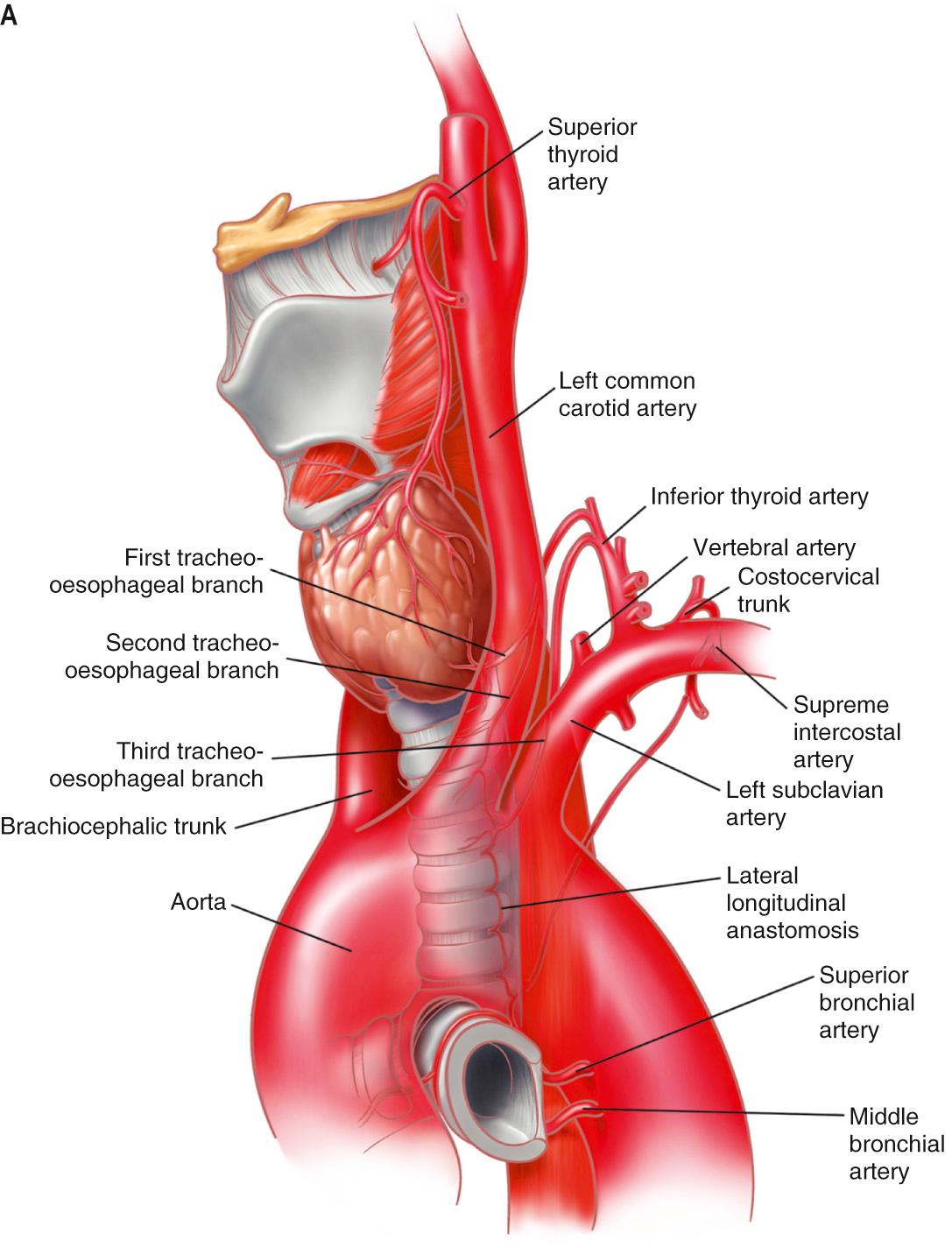
The thyroid isthmus lies anteriorly over the region of the second tracheal ring. The two lobes of the thyroid gland are closely applied to the lateral aspect of the trachea and share a common blood supply from the inferior thyroid artery ( Ch. 18 ). The brachiocephalic (innominate) artery crosses over the mid-trachea obliquely and can be found at a higher level in children and some adults. The recurrent laryngeal nerves lie in the tracheo-oesophageal groove. The left has a longer course than the right, entering the tracheo-oesophageal groove after looping around the aorta. The right enters the tracheo-oesophageal groove after looping round the right subclavian artery (although occasionally it may be given off directly from the right vagus). At the level of the carina, the left main bronchus passes under the aortic arch and the right main bronchus passes beneath the azygos vein. The pulmonary artery lies anterior to the carina. For further reading about the surgical anatomy of the trachea, see reference .
The upper half of the trachea lies mostly in the neck and can be approached via a collar incision. If further access is needed, it may be necessary to split the sternum to below the angle of Louis. For the cervical approach, platysma is divided in the line of the incision, the strap muscles are separated in the midline, and the pretracheal plane is entered. Dissection of the trachea is performed circumferentially at the site of the resection. Dissection above and below the site of resection should be limited to the anterior and posterior trachea, preserving the blood supply that enters the trachea laterally. It is important to remember that the recurrent laryngeal nerves lie in the tracheo-oesophageal groove and are at risk of damage. Unilateral damage will result in hoarse voice but bilateral damage can result in severe breathing difficulty and may even require a tracheostomy ( Ch. 17 ). For benign tracheal stenosis, the dissection at the level of the stenosis should take place as close as possible to the trachea to avoid damage to the nerve.
The lower trachea can be approached through a high (fourth intercostal space) right thoracotomy.
It can also be approached by median sternotomy transpericardially with dissection between the superior vena cava and the aorta; however, this provides limited access. This approach has been used to gain access to the bronchial stump after pneumonectomy when the stump has failed to heal.
The aim of a tracheal resection is to resect the abnormal trachea and reapproximate the ends with sutures. Tension at this anastomosis must not be excessive; otherwise, there is a significant risk of dehiscence. A number of manœuvres can be performed to reduce this tension. Flexion of the neck when the anastomotic sutures are tied and maintaining flexion for a week after the operation (sutures placed between the chin and the skin of the chest wall to avoid extension) are used in nearly all resections. Tension can also be reduced by performing a suprahyoid laryngeal release (dividing mylohyoid, geniohyoid, genioglossus and the hyoid bone), which allows the larynx to drop down. In the chest, a hilar release can be performed by freeing the hilum of the lung, dividing the inferior pulmonary ligament and dividing the pericardium around the right inferior pulmonary vein, so allowing the hilum of the lung to ascend. Rarely, reimplantation of the left main bronchus into the bronchus intermedius may be required. The length of trachea that can be resected varies with age, posture, extent of disease and previous tracheal surgery. Approximately half the length of the trachea can be resected in most adults and one-third of the more fragile juvenile trachea.
The brachiocephalic (innominate) artery lies anterior to the mid-trachea and this should be borne in mind when placing a tracheostomy; there is a risk of erosion of this vessel by the tracheostomy if it is placed adjacent to it.
The membranous trachea is thin and can be damaged by instrumentation. Percutaneous minitracheostomy or tracheostomy using the Seldinger technique can result in perforation of the back of the trachea. The trachea can also be damaged by excessive inflation of the balloon cuff of an endotracheal tube or tracheostomy; because the trachea is intimately related to the oesophagus posteriorly, a tracheo-oesophageal fistula can result. This anatomical relationship should also be borne in mind when stenting tumours of the oesophagus. Rarely, placement of a stent in a bulky tumour of the oesophagus can result in compression of the trachea and respiratory compromise.
The recurrent laryngeal nerve lies posterolaterally and can be damaged during mobilization of the trachea; dissection of benign lesions should be close to the wall of the trachea to avoid iatrogenic injury to the nerve.
Excessive circumferential mobilization of the trachea can devascularize the trachea, resulting in poor healing.
The brachiocephalic (innominate) artery crosses the mid-trachea anteriorly and there is a risk of erosion when a tracheostomy is placed close to the vessel. To counter this, avoid placing the tracheostomy low in the trachea.
The posterior wall of the trachea is thin and can be easily damaged by instrumentation, which can lead to a tracheo-oesophageal fistula. Placement of a minitracheostomy and tracheostomy using the Seldinger technique should therefore be done with bronchoscopic guidance. Care should be taken to avoid over-inflation of the balloon cuff of an endotracheal tube or tracheostomy tube.
The close relationship between the trachea and oesophagus means that there is a risk of compression with oesophageal stenting in the palliative setting; similarly, a tracheal stent can compromise the oesophagus. In this situation, it is therefore important to consider whether such stenting is appropriate if there is a risk of compressing the non-stented structure. Placement of stents in both trachea and oesophagus may be necessary but risks a tracheo-oesophageal fistula.
The lateral blood supply of the trachea means that there is a risk of devascularization if there is excessive circumferential mobilization during resection. Circumferential dissection should take place only at the level of the lesion, and further dissection only in the anterior and posterior planes.
During mobilization of the trachea, there is a risk of damage to the recurrent laryngeal nerves as they lie in the tracheo-oesophageal groove. Dissection should be kept close to the trachea for benign lesions. Formal identification of the recurrent laryngeal nerve is mandatory in malignant lesions.
The trachea usually bifurcates at the level of the upper half of the sixth thoracic vertebra into the right main bronchus and left main bronchus ( Fig. 47.2 ).
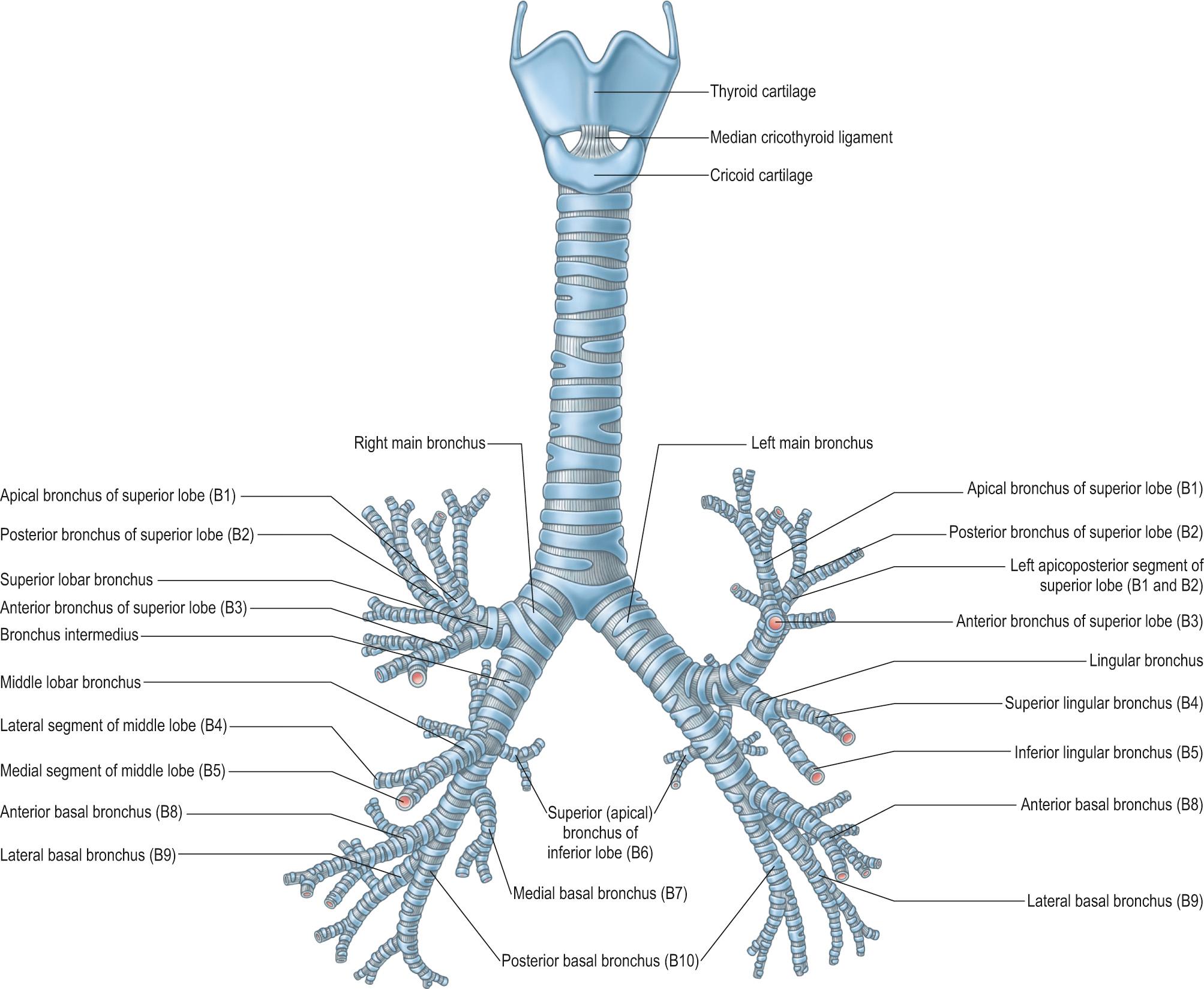
The right main bronchus is shorter than the left, starting at the trachea and finishing where the right upper lobe bronchus arises on its lateral wall about 1.2 cm from its origin. The right upper lobe bronchus gives off three segmental bronchi (apical, posterior and anterior segmental bronchus). Although usually a trifurcation, various combinations of branching can occur. The finding of just two orifices should prompt a search to make sure a tracheal bronchus is not present.
The intermediate bronchus then continues and lies posterior to the right pulmonary artery as it courses down the fissure. After 1.7–2 cm, the middle lobe bronchus arises and gives off a medial and a lateral segmental bronchus. The superior segmental bronchus of the lower lobe is usually given off posteriorly, slightly distal to the origin of the middle lobe bronchus; it may sometimes arise at the same level or above. Further distally, the basal stem bronchus gives off segmental bronchi to the medial, anterior, lateral and posterior basal segments.
Numerous anomalies of this typical arrangement occur. A tracheal bronchus arising from the lateral wall of the trachea can occur in up to 2% of individuals. This may supply the apical segment of the right upper lobe or actually represent a misplaced right upper lobe bronchus. More rarely, a bronchus can arise from the medial aspect of the bronchus intermedius; this is usually blind-ending but can be associated with some branching and a small amount of pulmonary parenchyma.
As the right main bronchus is more vertically orientated than the left main bronchus and is more in line with the trachea, it is more common for inhaled foreign bodies to be lodged in the right airway. However, it is uncommon for any foreign body to be lodged in the right upper lobe bronchus because this usually comes off the right main bronchus at an acute angle.
The left main bronchus is longer than the right, being 4–6 cm in length. The left upper lobe bronchus divides into superior and lingular branches. The superior branch divides into apicoposterior and anterior segmental branches. Occasionally, the superior branch may trifurcate into apical, posterior and anterior segmental branches. The lingular branch divides into superior and inferior segmental branches. Approximately 0.5 cm distal to the upper lobe take-off, the lower lobe stem bronchus gives off the superior segmental bronchus of the lower lobe. The basal trunk continues for 1.5 cm before dividing into two branches, an anterior basal segmental branch and a common stem for the lateral and posterior basal segmental branches.
Variations occur in the way the upper and lingular divisions divide into their segments. A subsuperior bronchus can arise from the lower lobe bronchus. Very rarely, the right lower lobe (and sometimes a portion of the middle lobe) can be supplied by a bronchus arising from the left main stem bronchus that crosses the mediastinum (so-called bridging bronchus). Bronchial isomerism can occur with identical branching in both lungs and is frequently associated with other congenital abnormalities. Very rarely, a lobar bronchus may be absent.
A knowledge of bronchoscopic anatomy is essential for the surgeon to plan surgical resection. It is also relevant for the anaesthetist who needs to provide selective lung ventilation so that the lung that is to be operated on is collapsed during surgery. This is usually achieved by using a double-lumen endotracheal tube with a bronchial lumen that is passed down into one main bronchus and a tracheal lumen that sits above the carina and ventilates the other lung. The anatomical differences between the right and left main bronchi are very important. Because the left main bronchus is long before it branches, it is possible to place the bronchial lumen of the double-lumen tube in the main bronchus so that ventilating both the upper and lower lobes is straightforward. A left-sided double-lumen tube is used for most thoracic procedures but is generally avoided for any left-sided resection that could involve the main bronchus. In this situation, a right-sided double-lumen tube is used. The major challenge with a right-sided tube is maintaining ventilation of the right upper lobe because of its early take-off from the right main bronchus. This is managed by having a hole in the lateral aspect of the bronchial lumen of the double-lumen tube that allows ventilation of the right upper lobe if the hole is aligned with the origin of the right upper lobe. If there are issues with a right-sided tube placement, it is still possible to use a left-sided tube for left-sided lung isolation when the resection involves the distal left main bronchus. In this scenario, it is important to withdraw the double lumen tube as far proximally as possible beyond the planned resection margin just before it is divided. The alternative approach is to use a bronchial blocker to isolate the lung. This is a balloon catheter that is passed through a single-lumen tube and placed in the main bronchus to block ventilation of that side. Since the right main bronchus is short, it can be difficult to place this on the right without compromising the right upper lobe bronchus. In an emergency situation where a right thoracotomy is needed, a small single-lumen tube can be passed into the left main bronchus for the duration of the procedure and pulled back into the trachea to ventilate both lungs at the end of the procedure.
Bronchoscopy is a useful diagnostic and therapeutic procedure for airway conditions. For the surgeon, it is also an important preoperative tool for assessing the extent of resection required for lung tumours. While peripheral tumours may not be visible at bronchoscopy, more central tumours arising in the lobar bronchi will be visible. The surgeon decides whether the tumour and associated lobe can be resected with a margin of normal tissue or whether it involves another branch of the bronchial tree, meaning that either a sleeve resection, a bilobectomy or a pneumonectomy needs to be performed.
Bronchoscopy can be performed using fibreoptic bronchoscopy or rigid bronchoscopy. Fibreoptic bronchoscopy is normally carried out under local anaesthetic with light sedation (if the patient can tolerate the procedure) or under general anaesthetic with airway protection (for example, laryngeal mask, single-lumen intubation or rigid bronchoscopy). When bronchoscopy is performed under local anaesthetic, the bronchoscope is usually passed through the nose and then under direct vision through the vocal cords into the trachea. Alternatively, this can be performed through the mouth with a mouth guard protecting the teeth and the bronchoscope. The fibreoptic bronchoscope is a useful tool for initial diagnosis and assessment of airway pathology. It has an operating channel through which endoluminal biopsies and therapeutic procedures such as airway cautery/lasering can be performed. It is also a useful tool for airway toileting and secretion clearance, and recently has been used for placement of endobronchial valves and coils. Using a specialized fibreoptic bronchoscope with an ultrasound probe at its tip, it is now possible to perform endobronchial ultrasound (EBUS), which is particularly useful for endobronchial biopsies and sampling of lymph nodes close to the airway.
In situations where a larger endoluminal operating field is needed and a secure airway is required during intervention, rigid bronchoscopy should be used. Such situations include airway foreign body, airway bleeding and endoluminal tumour debulking/stenting. Rigid bronchoscopy is performed under general anaesthesia. The surgeon inserts the bronchoscope into the mouth and, while protecting the teeth with his/her fingers, passes the bronchoscope over the tongue until the epiglottis is seen. The bronchoscope is then pushed anteriorly behind the epiglottis, allowing the vocal cords to come into view; the bronchoscope is next rotated and the beak of the instrument is passed through the cords into the trachea. Usually, the surgeon then passes a straight telescope or flexible bronchoscope through the rigid bronchoscope to complete the examination.
The right lung has three lobes (upper, middle and lower) and two fissures (oblique and horizontal). The oblique fissure separates the lower lobe from the middle and upper lobes; it begins posteriorly at the level of the fifth rib and runs forward along the course of the sixth rib to the diaphragm. The horizontal fissure separates the middle from the upper lobe; it begins in the oblique fissure in the mid-axillary line at the level of the sixth rib and runs anteriorly to the costochondral junction of the fourth rib. The fissures may be complete so that the lobes are completely separate, or incomplete where the lobes are not easily separable. In more than 50% of cases, the horizontal fissure is incomplete and the middle lobe is fused to the anterior part of the upper lobe.
The left lung has two lobes (upper and lower) separated by the oblique fissure, which runs obliquely downward from between the third and fifth ribs to end at the level of the sixth or seventh costochondral junction.
Additional fissures may delineate accessory lobes, the most common being the posterior accessory, inferior accessory, middle lobe of left lung (lingual) and azygos lobes.
When planning resection, surgeons look carefully for the fissures on CT scans; they are usually visible and will indicate which lobe contains a lesion and whether more than one lobe is involved.
For further reading about pulmonary lobes and fissures, see reference .
Each lobe of the lung is divided into a number of bronchopulmonary segments, which can be regarded as individual functional units ( Fig. 47.3 ). Each segment is served by a segmental bronchus lying centrally within the segment; the veins are situated at the junction between adjacent segments.
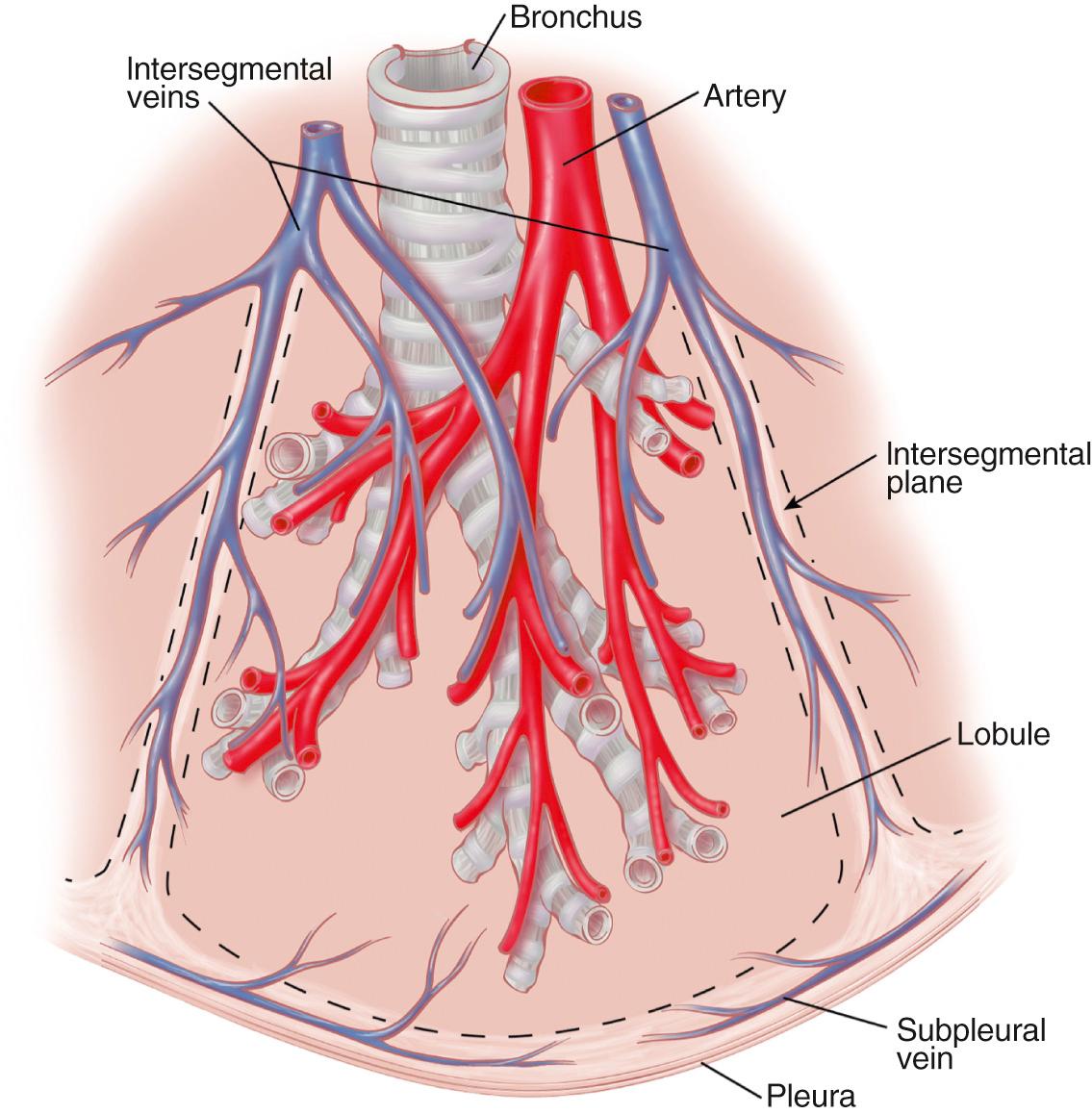
Historically, the nomenclature of some of the bronchopulmonary segments has been the subject of debate. It was not clear whether the upper lobe should be regarded as three segments or two (an apicoposterior and an anterior segment). The medial basal bronchus on the left was absent in one classification and part of the anteromedial basal bronchus in another. In 1950, the Thoracic Society appointed a subcommittee to review the terminology and agree an international terminology, which is still widely adopted today. The apical segment of the lower lobe is now more usually called the superior segment of the lower lobe.
Prediction of postoperative lung function, which is important for deciding on the extent of resection, can be estimated by establishing the number of segments that are non-functional as a consequence of the tumour and the number of functioning segments that would need to be resected to clear the tumour. Knowing the existing lung function of the patient, it is possible to calculate the percentage loss of lung function (making the assumption that the segments of the lung have equal volume) and therefore to decide whether the patient will be left with enough functioning lung to survive the operation and have a reasonable quality of life.
The main pulmonary artery arises from the pulmonary anulus surrounding the subpulmonary infundibulum at the base of the right ventricle, and slopes posterosuperiorly, at first anterior to the ascending aorta and then to its left; at the level of the fifth thoracic vertebra, inferior to the aortic arch at the left of the midline, and lying above the left main bronchus, it divides into right and left pulmonary arteries. The right main pulmonary artery is longer than the left but the segment lying outside the pericardium before the first branch is given off is shorter than its counterpart on the left. The branches of the pulmonary artery are more variable than those of the bronchi. They tend to lie close to the segmental bronchi and their branches ( Figs 47.4 , 47.5 ). For further reading about the pulmonary vascular system, see reference .
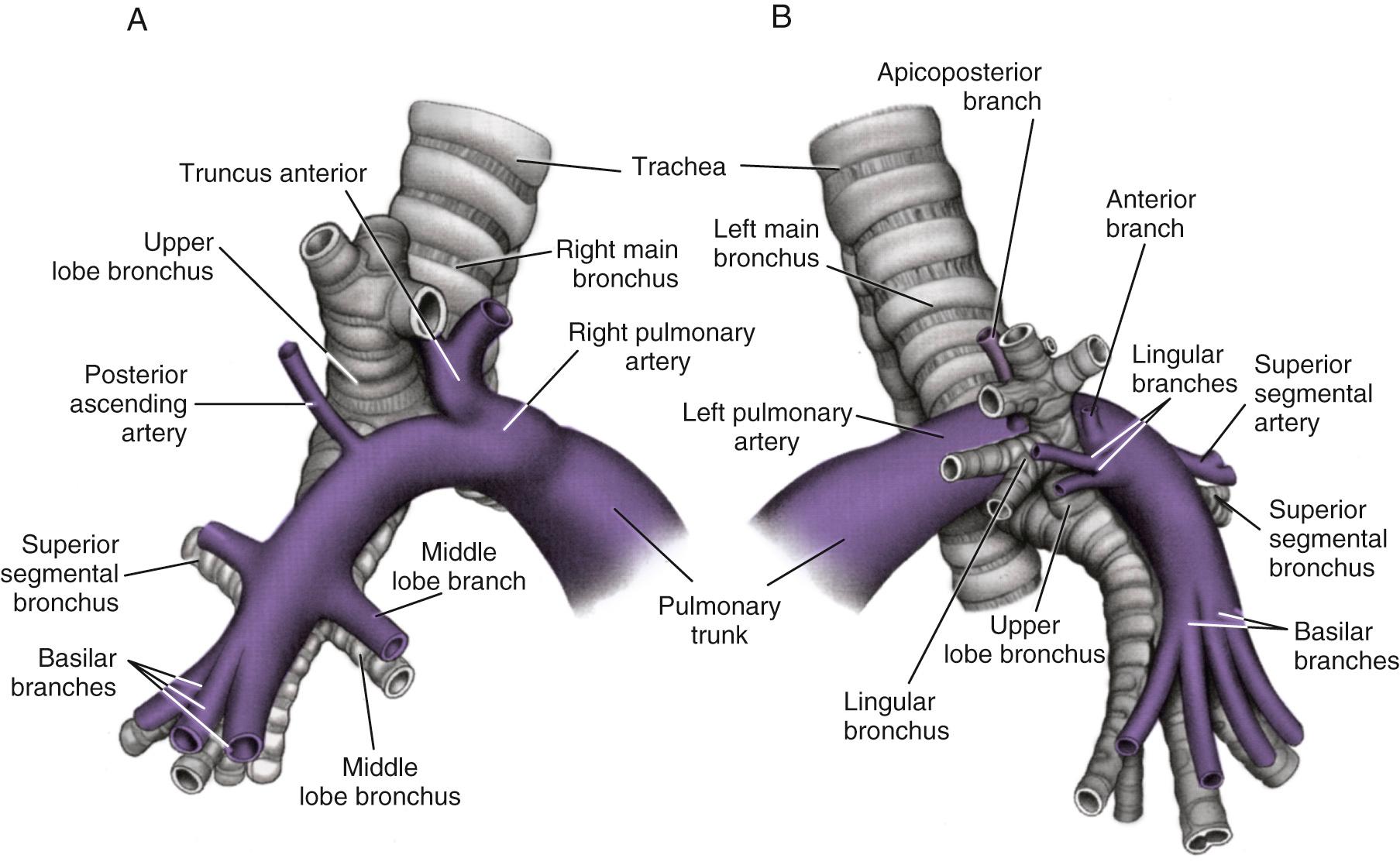
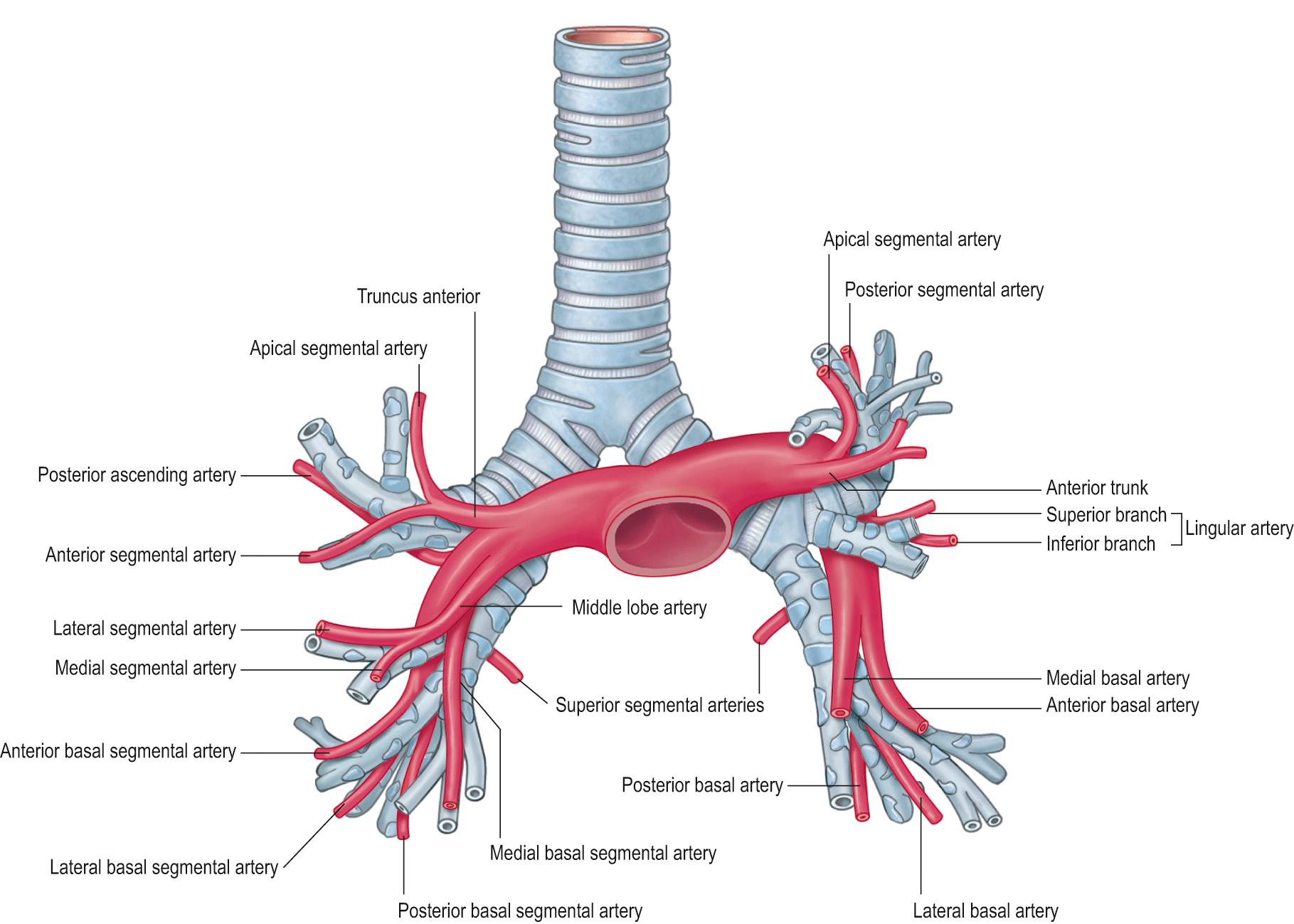
Become a Clinical Tree membership for Full access and enjoy Unlimited articles
If you are a member. Log in here